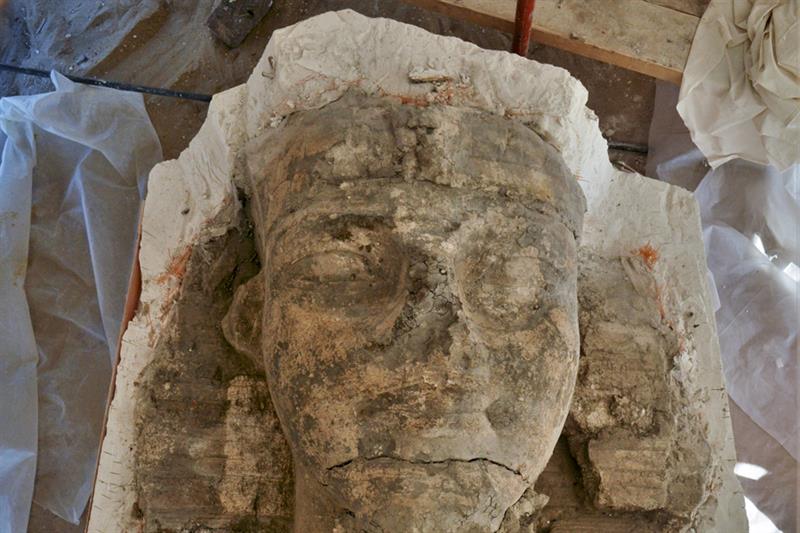New discoveries in Luxor and Sinai
Nevine El-Aref , Tuesday 11 Jan 2022
Gigantic blocks from statues of Amenhotep III in Luxor and the remains of a mining mission in Sinai were discovered this week, reports Nevine El-Aref

An Egyptian-German archaeological mission led by Hourig Sourouzian made a major new discovery at the Amenhotep III Temple on the west bank at Luxor this week during work carried out within the Colossi of Memnon and Amenhotep III Temple Conservation Project.
Sourouzian explained that the mission had uncovered a collection of huge limestone blocks belonging to a pair of gigantic limestone statues of Amenhotep III in the shape of sphinxes wearing the ancient Egyptian nemes headdress, the royal beard, and a broad collar around their necks.
Both colossal sphinxes were found half submerged in water at the rear of the gateway of the Third Pylon of the Temple and have been subject to meticulous cleaning and consolidation. One of the pieces has the end of the royal name "the beloved of Amun-Re" on its chest. Other pieces of the body and paws have been unearthed and removed for careful conservation.
Mustafa Waziri, secretary-general of the Supreme Council of Antiquities (SCA), announced the discovery of the blocks, three busts of the lioness god Sekhmet and the remains of walls and columns on the façade of the Peristyle Court and in the Hypostyle Hall of the temple.
The materials will be reassembled with other parts found earlier on the site and re-erected in their original locations during the site-management project.
Pieces of sandstone wall decoration depicting scenes from the Heb-sed, the jubilee festival of Amenhotep III, and offering scenes to diverse deities were also uncovered, along with a small granodiorite statue of an official seated probably with his wife and likely to be dated to the Post-Amarna Period when restoration work in this Temple was carried out.
Column bases and foundation blocks in the southern half of the Hypostyle Hall were also found showing that it was much larger than previously thought with more columns.
Sourouzian said the pair of colossal sphinxes attested to the beginning of the processional way leading from the Third Pylon of the Temple to the Peristyle Court where the Festival of the Valley was celebrated each year, as well as the jubilee festivals of the king in the last decade of his reign.
"Preliminary research on these colossal sphinxes has revealed that their length was about eight metres, making them the second-largest sphinxes produced in ancient Egypt after the Great Sphinx of Giza, measuring 22 metres long, and almost equal to the alabaster sphinx at the Mit Rahina site measuring eight metres long," she said.
The blocks are undergoing restoration before they are re-erected in their original locations in the temple.
In addition to the work at the temple, the Colossi of Memnon were monitored and scanned and their surfaces thoroughly cleaned of bird droppings.
Two quartzite colossi of Amenhotep III that had previously been re-erected by the project at the gate of the Second Pylon were documented, photographed, and photo-scanned. Cleaning and desalination work was carried out and statue fragments rejoined.
At the Third Pylon, larger parts and hundreds of smaller fragments belonging to the colossi of Amenhotep III in travertine (Egyptian alabaster) were thoroughly documented, cleaned, and photo-scanned.
Spectacular rejoins were made by the conservation team, and the prospect of raising these colossi in their original setting is likely to be realised in the near future, when the water table is lowered.
The temple was the largest of all the ancient Egyptian funerary temples on the west bank and was toppled by a strong earthquake that hit the country in antiquity.
The Colossi of Memnon and Amenhotep III Temple Conservation Project has worked since 1998 under the auspices of the Ministry of Tourism and Antiquities and the German Archaeological Institute in Cairo. Various new structures have been uncovered, along with many architectural remains. A monumental stela and numerous colossal statues of the king have been mounted and raised in their original places.
Sinai discovery: This week's second discovery was made in the Wadi Al-Nasb area in Sarabit Al-Khadem in South Sinai, where there were once turquoise mines and the temple of the goddess Hathor, the lady of turquoise.
An Egyptian archaeological mission led by Mustafa Noureddin uncovered the remains of a Middle Kingdom mining mission made of sandstone that was once used to supervise the mining of copper and turquoise more than 4,000 years ago.
Waziri said that the Egyptian mission was the first to work at Wadi Al-Nasb and at the mining site overlooking the ancient well that once supplied water to the mining district and measures 225 square metres in area. The building consists of two main halls, two rooms, and a staircase leading to the roof. The floor of the building is made of sandstone slabs.
Preliminary study indicates that the premises were built during the Middle Kingdom and continued to be used during the New Kingdom and then during the Late Period with few changes in design.
Ayman Ashmawi, head of Ancient Egyptian Antiquities at the SCA, said that modifications had been made to the building over time and that it was finally used as a copper workshop. The Egyptian mission unearthed furnaces in the top layers, uncovering copper ore, four rectangular copper ingots, crucibles, and slag, which is the waste material produced in the extraction of copper.
Wadi Al-Nasb was the largest ancient Egyptian smelting site in the Sinai Peninsula, and the amount of copper slag there is estimated at 100,000 tons. The site is among the most important copper sites in the Eastern Mediterranean and the area is famous for its unique rock inscriptions from the middle and new kingdoms.
*A version of this article appears in print in the 13 January, 2022 edition of Al-Ahram Weekly.
-- Sent from my Linux system.
No comments:
Post a Comment